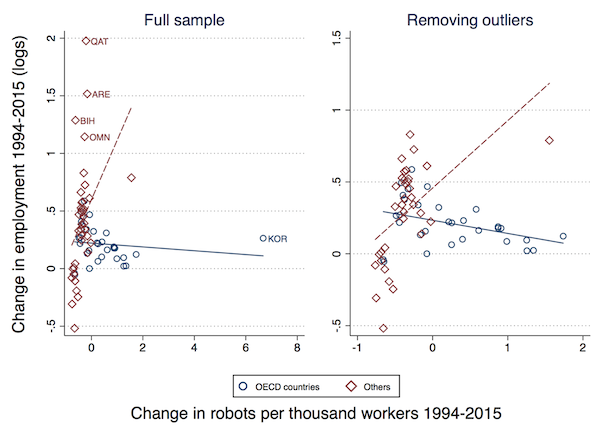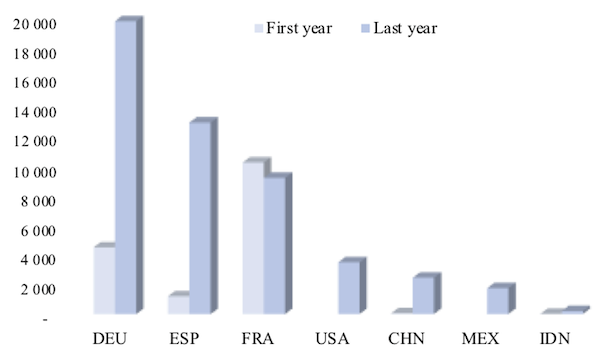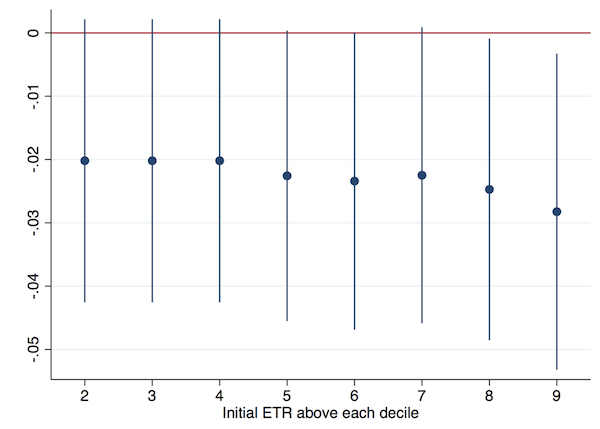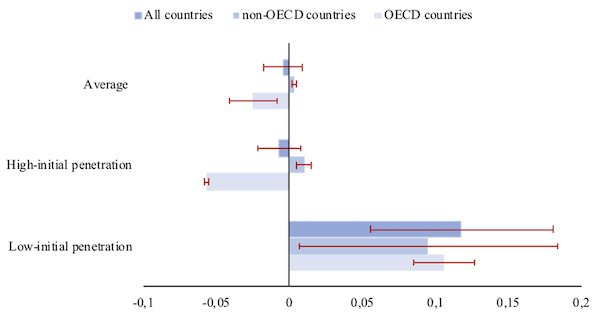Lambert: Pleasing to see the relatively non-obfuscatory term “robot” used.
By Massimiliano Calì, Senior Economist, World Bank, and Giorgio Presidente, Postdoctoral researcher, Oxford Martin School, Oxford University. Originally published at VoxEU.
Do automation technologies constitute an opportunity or a threat for developing countries? This column uses data on Indonesian manufacturing firms to document a positive impact on employment of adopting robots. This finding contrasts with the existing evidence of negative impacts in economies at relatively advanced stages of automation, and could be explained by diminishing returns to robots, given the relatively low robot adoption in Indonesia.
Ever-more ubiquitous automation technologies present the economies that adopt them with an apparent trade-off between firm-level productivity gains (Acemoglu et Restrepo 2020, Koch et al. 2019) and adverse employment impacts due to the labour-saving nature of automation (Acemoglu and Restrepo 2020, Dauth et al. 2017). This trade-off has so far been documented in countries at a relatively advanced stage of automation.1
Yet, it is not clear that the existing evidence on the impacts of automation provides useful guidance for countries at earlier stages of automation, which includes most developing countries today. Given that automation technologies may be subject to strong diminishing returns (Graetz and Michaels 2018), their adoption may be more likely to increase labour demand in countries at early stages of adoption. Figure 1 provides some suggestive evidence in support of this idea focusing on industrial robots, an important class of automation technology. It shows that the correlation between robot penetration and employment is negative for OECD countries, which have higher robot penetration, and positive for non-OECD countries.
Figure 1 Robot penetration and employment changes: OECD vs non-OECD countries

Note: The figure plots the correlation between the change in residuals from a regression of log-employment on the share of population above 55 years old over population between 20 and 49 years old, and changes in robot penetration over the same period. Robot penetration is defined as the stock of industrial robots per 1000 employed workers.
Sources: International Federation of Robotics; Penn World Table; World Bank.
This is an important knowledge gap as the penetration of automation in developing countries is expected to grow significantly over the coming decades (Hallward-Driemeier and Nayyar 2017). In a recent paper (Calì and Presidente 2022), we help to fill this gap by examining the impact of robots’ adoption on employment in Indonesian manufacturing. We focus on the late 2000s-early 2010s, when the penetration of robots in Indonesia was considerably lower than in the other countries with available micro evidence.
Figure 2 illustrates the extent of this discrepancy by plotting the number of robots per million manufacturing workers in the first (whenever available) and last years of the existing analyses in each of these countries. The data for robots come from the International Federation of Robotics (IFR), which collects data on robot imports from each national robotics association. The data for manufacturing employment are from the International Labour Organization (ILO) and, for China, from the United Nations Industrial Development Organization (UNIDO). Taking the last years of the analyses, for example, which are close in range for most countries, Indonesia’s robot penetration was the lowest in the sample by a factor ranging between 9 (relative to Mexico in 2015) and 99 (relative to Germany in 2014). And similar differences apply also when taking the first years of the analyses.
Figure 2 Robot penetration in Indonesia vs other countries with evidence on the impact of automation

Note: The figure shows the number of robots per million manufacturing workers in the first (if available to us) and last years of the respective countries’ analysis. These are: 1994-2014 (DEU); 1990-2015 (ESP); 2010-15 (FRA); 1993-2007 (USA); 2006-16 (CHN); 2000-15 (MEX); 2008-15 (IDN).
Sources: IFR; ILO; UNIDO.
Another interesting feature of the Indonesian context is that the total number of robots increased significantly after 2010, with the total stock increasing almost ten-fold between 2008 and 2015. This acceleration was highly heterogeneous across sectors. By the end of the sample period in 2015, the penetration of robots in the most automated industries, such as Motor Vehicles, was comparable to that of advanced economies. Other industries, such as Textiles, have seen no penetration throughout the period.
The Positive Employment Impact of Robots on Indonesia’s Local Labour Markets
To identify the effects of robot penetration on local employment, we focus on regencies, which are the second level of sub-national administrative division in Indonesia and approximate local labour markets reasonably well.2 In line with previous literature, we construct a regency-specific robot exposure measure by interacting baseline industry shares in employment at the regency level with annual industry-specific robot imports (Acemoglu and Restrepo 2020, Dauth et al. 2017). We then regress changes in regency-level employment in 2008-15 on changes in this robot exposure over the same period, controlling for various time-invariant and time-varying factors. We also address the plausible endogeneity of the robot measure by instrumenting it with the average industry-specific robot penetration in OECD countries, which are ahead of Indonesia in terms of robot adoption.3
In contrast to the available micro evidence in other countries, our analysis documents a positive manufacturing employment effect of robot adoption across Indonesian local labour markets. The magnitude of the estimated coefficient in our preferred specification implies that employment grew 31 percentage points more in regencies with one additional robot per 1000 base-year workers over the 2008–15 period (significant at the 1% level). We assess in detail the validity of the identification (Goldsmith-Pinkham et al. 2020) and perform a large battery of tests, which provides confidence on the robustness of the positive employment effect of robots.
Diminishing Returns to Automation and the Positive Employment Impact
A simple task-based model along the lines of Acemoglu and Restrepo (2018) captures the key intuition. Consider an economy with a fixed set of tasks performed by workers ordered by increasing level of complexity (i.e. from routine to highly sophisticated tasks). At low levels of automation (that is, with low shares of automated tasks), an additional robot would replace workers in a routine task where humans have low comparative advantage. As a result, the productivity gains of robot adoption are relatively large. The gains become smaller at higher levels of automation, as robots displace workers with increasing levels of comparative advantage at performing their tasks. At the same time, the displacement effect of robots increases as the range of tasks performed by humans shrinks due to automation, and so the marginal product of labour decreases as workers become redundant. With productivity gains decreasing and displacement effects increasing with automation, the net returns to robot adoption diminish, and hence the employment effects become more negative.
We test this hypothesis using Indonesia’s extensive panel data of manufacturing plants. Unlike other studies in high-income countries, we do not observe the use of robots by plants. Instead, we develop a measure of plant-level exposure to robots based on Graetz and Michaels’ (2018) definition of occupations’ ‘replaceability’ by robots. Using Indonesian labour force survey data, we document that secondary-educated workers dominate occupations at high risk of automation in Indonesia. We use this observation to construct a plant-specific measure of exposure to automation, by interacting industry-specific annual robot imports with the baseline share of secondary workers at the plant level. We provide various pieces of evidence consistent with the finding that occupations at risk of automation are dominated by secondary-educated workers. For instance, industries with an initial large share of secondary-educated workers adopted relatively more robots in subsequent years. Similarly, industry average investment in machinery and equipment, which includes investment in robots, is positively correlated with industry imports of robots.
We regress yearly plant-level employment on the robot exposure measure controlling for a wide array of fixed effects, including plant and industry-year effects, downstream exposure to robots and a plant-level index of technological sophistication to capture possible confounders. The results imply that on average, one additional robot per 1,000 workers increases the plant’s employment by 1%. The effects appear to be driven by the large increases in productivity resulting from automation. On average, one additional robot per 1,000 workers increases total factor productivity (in quantity terms) by 7% and reduces real marginal costs by 10%.
The analysis also supports the hypothesis of diminishing returns to automation. The employment elasticity of robot adoption becomes less positive for plants above the 8th decile of the distribution of initial exposure to robots (Figure 3). For plants in the top decile, one additional robot per 1,000 workers is associated with a positive but not statistically significant employment elasticity of robot adoption. We observe a similar pattern for productivity.
Thus, the positive impact of robot adoption on local manufacturing employment appears to be driven by plants with high levels of untapped automation possibilities. In a country at the initial stage of automation, such as Indonesia, these plants represent the bulk of the entire manufacturing sector population.
Figure 3 Employment impact of exposure to robots relative to less exposed plants, by decile of the distribution of initial exposure to robots

Note: The figure shows point estimates and 90% confidence intervals of the interaction between exposure to robots and a categorical variable representing whether initial exposure to robots is above each decile of its distribution.
Source: authors calculations based on Statistik Industri and IFR.
Robots for Economic Development?
Finally, we examine the possible external validity of these results. To that end, we analyse the relation between employment and robot imports across 61 OECD and non-OECD economies in 12 industries over the 2007-15 period. The analysis is based on a 2SLS estimator, instrumenting robot density with a leave-out mean constructed from the same industry-year pairs in other countries. The findings suggest significant diminishing returns to automation across countries as well. Robot adoption is negatively associated with manufacturing employment in OECD countries – particularly at high levels of penetration – and positively in non-OECD countries (Figure 4).
Figure 4 Employment impact of robots in 61 countries and 12 industries, 2007-2015

Note: The figure shows 2SLS estimates of the impact of robot penetration and 90% confidence intervals in a sample of 61 countries and 12 industries, from 2007 to 2015.
Sources: authors’ calculations based on IFR, OECD Structural Analysis Database, Statistik Industri.
While suggestive, these results cast some doubt on the idea that adoption of automation technologies in developing countries impairs their demand for labour as they move from very low to higher automation rates (Diao et al. 2021). Additional data on firm-level robot adoption in developing economies, particularly those at early stages of industrialisation, would be necessary to test this hypothesis in other contexts.


To a certain extent I think this is asking the wrong question. Economic growth is ultimately productivity growth. If robots raise productivity, then they increase the wealth of the country. It really is that simple.
The problem of course is that robots tend to be built by, sold, then ultimately owned by someone (i.e. an already wealthy capitalist somewhere) and so the benefits of productivity gains go to capital and a small number of elite skilled workers, rather than the majority. In other words, it is a distributional issue. If the robots were owned by a workers cooperative, there wouldn’t be a problem (except for those who for one reason or another don’t get to be part of the co-operative).
To a large extent this has been a process we’ve seen ongoing for decades in advanced countries, where its proven very hard to give ‘good’ jobs to the majority. European countries have tended to address this through social welfare scheme and employing people for social ends (or BS jobs like… well, fill in your own favourite example), while Asian countries have deliberately created inefficient service industries to soak up excess workers. This obviously can create a problem when robots extend out to those service industries as is increasingly the case.
I think South Korea and France are good examples of where this approach can be limited. France has a highly successful high tech industry but is struggling to provide some sort of work to its increasingly large population of low skilled workers. You can see this geographically as cities like Paris and Bordeaux surge ahead while large sections of the country are little more than welfare dependencies. In South Korea, during high growth phases the majority of people could be given a ‘safe’ job in one of the big chaebol concerns, with the rest of the workforce soaked up in low skill work. But as industry becomes more productive, there is an increasing disconnect between those who work in these protected, pensioned jobs, and those who worked very hard to make it, but end up instead working midnight in a 7-11. This is one reason I suspect why electorally highly conservative candidates are making inroads to the young male population.
I agree with your comment. But I am a bit puzzled by your last sentence. Perhaps you could explain further.
I didn’t explain it well – but in short I think the disconnect between a robotised high productivity economy with the rest of a countries economy is leaving an army of mostly younger male, relatively well educated people adrift. When the left is not providing an alternative, left parties are seen as part of the problem (especially when it is seen as too wokist). This is leaving a large cohort available to the right wing. In South Korea it seems the recent Conservative victories owed at least some of their success to recruiting younger men on an anti-feminist manifesto. So the right reaps the benefit of problems largely caused by the right.
There’s the funny part though. The government’s response is often to create a bunch of highly paid bs jobs (this can be debated case by case) to reassert a middle class as the paychecks of traditional middle class jobs fall farther behind. If someone gets stuck outside of that club doing a necessary job but getting paid poorly to do it, then what do they think? A young person may not recognize that labor demand has become increasingly synthetic. They are then susceptible to believing that someone has somehow taken their job, instead of realizing that supply and demand doesn’t apply to a large chunk of the labor force and instead it is a bizarre form of meritocracy. It’s a cultural problem because a lot of people feel like they are treated as “blue collar” low lifes even while doing important work. It’s political to the extent that they choose who to blame and conservative elements are attempting to hijack that anger and frustration.
PK said:
The problem of course is that robots tend to be built by, sold, then ultimately owned by someone (i.e. an already wealthy capitalist somewhere) and so the benefits of productivity gains go to capital and a small number of elite skilled workers, rather than the majority. In other words, it is a distributional issue. If the robots were owned by a workers cooperative, there wouldn’t be a problem (except for those who for one reason or another don’t get to be part of the co-operative).
====
PK: I think that is a very, very fruitful line of address.
This is the core paradox of capitalism:
Capitalists want to make money. Automation reduces costs (labor) while maintaining or increasing production.
Capitalists need to sell their products. If labor’s been squeezed out, no consumers.
Paradox solution 1: Massive credit expansion. Buy now, pay later! Shift demand forward.
Paradox solution 2: Massive money printing. Print and buy now. Shift demand forward.
Solution 1 and 2 are apparently running out of gas. Fin economy good, real economy bad. Valuations not reality-based. Buy hard assets, because the cash….?
Will WW3 help? Wreck other people’s production capacity (China) or get some new resources to sell (Russia)?
PK’s remedy – to put automation into the hands of the middle class – is the _right_ remedy.
But there’s a catch, and it’s a doozy: If the middle class is going to “own the automation” and “capture the benefits of productivity” and thereby “increase aggregate demand” … they’re going to have to get good at a few things they’re not real good at right now.
Even if a co-op owns the automation, the members of the middle class have to own and operate that co-op. “Operate” as in “know what they’re doing”.
A while back, in a thread far, far away, I mentioned the solution PK put forward above, and Lambert dismissed it, saying (my paraphrase) “The middle class isn’t going to learn to do automation”.
For most of us, there may not be much choice: Either get 1) squashed by the automation steam-roller, or (2) get into the driver’s seat of the automation steam-roller, or (3) figure out a way to get transfer payments or (4) belong to a Protected Income Stream group (medical, defense, etc.) or (5) join the next Jingo-War and wreck a foreign nation’s productive capacity
or, most probably (6) continue to be marginalized, while the Bad Guys repress you and spy on you to make sure you don’t get too restive.
Lambert, hopefully I recalled that dialog accurately, and if not, I apologize. It’s been a while.
IMO the most elegant solution is a Carbon Tax/UBI. Tax the pollution (mostly of the rich) and use it to directly subsidize everyone. That will create demand for workers, and eliminate poverty and smooth income inequality, with no perverse incentives. It will discourage pollution, but that is good. Get rid of our tax code, it’s terrible. Payroll taxes are terrible, taxes on improvements on real estate are terrible, income is to easy to hide so income taxes are terrible.
No, a UBI is a bad idea.
1. The US will never provide one that is adequate to provide even for an adequate standard of living. And even though the immediate obstacle is political, it’s actually sound. That much additional demand without providing for a massive, as in unattainably large increase in productive capacity would lead to crushing inflation.
2. Therefore any UBI will be an income subsidy. Employers will cut wages in light of the UBI. It will simply serve as a subsidy to employers.
And on carbon taxes:
https://news.climate.columbia.edu/2021/04/26/retire-carbon-tax/
“More than two-thirds of the US economy (considered an OECD country) is made up of consumer spending”
“Consumer spending accounts for more than two-thirds of U.S. economic activity”
“Consumer spending is the backbone of the U.S. economy, making up over two-thirds of our $20 trillion annual GDP”
These are familiar statements in economic discussions, found in economic textbooks, etc.
Next, a basic summary on consumer spending and the economy. The basis is the economic mantra about consumer spending:
https://www.thebalance.com/consumer-spending-definition-and-determinants-3305917
An excerpt:
“Almost two-thirds of consumer spending is on services, like real estate and health care. Other services include financial services, such as banking, investments, and insurance. Cable and internet services also count, as do services from non-profits.
The remaining one-third of our personal consumption expenditure is on goods. These include so-called durable goods, such as washing machines, automobiles, and furniture. More frequently, we buy non-durable goods, such as gasoline, groceries, and clothing..”
Also of note in this basic breakdown on consumer spending: The Five Determinants of Consumer Spending.
This info, which has been around for decades, concludes my examination of the diminishishing returns of robot automation.
I think I follow at least some of your drift — but it might be helpful to better tie together some of the threads in your examination of automation and its impacts on employment.
Name something on the consumer spending category list that a robot is going to need.
Think about this over financialized global economy. Who’s imagining a robot taking out a loan to buy something to impress another robot?
But I’ll go further:
The kind of economy that will be had with
sci-fi levels of automation is not one that can be reconciled with the consumer spending tropes and previous notions about supply and demand.
“Do automation technologies constitute an opportunity or a threat for developing countries? This column uses data on Indonesian manufacturing firms to document a positive impact on employment of adopting robots.”
Upon reading the above quote, I remember Indonesia’s Minister of Finance advocating for universal basic income precisely due to reasons of automation (i.e. robots) in 2017:
“”If robots destroy employment opportunities, then UBI should be introduced,” Finance Minister (FM) Sri Mulyani Indrawati said on the sidelines of an annual meeting of the International Monetary Fund (IMF) and the World Bank in Washington DC on Thursday (12/10)…” (1)
In January 2020, The Fiscal Policy Agency under the Finance Ministry later actually produced a report titled ‘Universal Basic Income: Feasibility Application in Indonesia’. (2) However, the word ‘robot’ is nowhere to be found, the reason given in page 3 of the report instead being: “some of its main features work just like social protection programs”.
Some segments of the Indonesian civil society (CSO) have also been noticeably busy advocating for UBI since the FM’s statement in 2017, creating a dedicated UBI website and holding related events (3) and even a specialized doctoral program for UBI. (4)
Now, as someone who is advocating for a Modern Monetary Theory (MMT) understanding of macroeconomics and its attendant policy of job guarantee (JG) for Indonesia, I am suspicious of this article. A main reason is the Indonesian UBI proponents, from the CSO elites all the way up to FM, seem to go out of their way to sideline MMT and JG in favor of UBI in their public pronouncements.
To my mind, the accusation of some MMT and JG proponents that UBI is an extension of neoclassical/neoliberal economic policy making could perhaps be true in Indonesia. There seems to be some sort of coordination going on to make sure UBI is within the overton window, and MMT and JG without, in which this article is nothing but another evidence.
Notes:
(1) https://jakartaglobe.id/business/indonesia-to-study-universal-basic-income/
(2) https://innovativefinancinglab.com/assets/attachments/books/fc4b4b484864bd67115bb8843140569d.pdf
(3) http://jamesta.org
(4) https://rccc.ui.ac.id/2021/06/08/phd-fellowship-on-basic-income-for-nature-and-climate-at-the-university-of-freiburg-germany-for-applicants-from-indonesia/